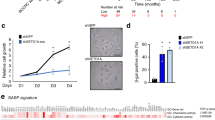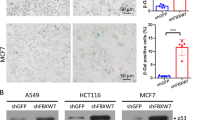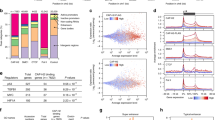Abstract
The Polycomb group protein Bmi-1 is an essential regulator of cellular senescence and is believed to function largely through the direct repression of the Ink4a/Arf locus. However, concurrent deletion of Ink4a/Arf does not fully rescue the defects detected in Bmi-1−/− mice, indicating that additional Bmi-1 targets remain to be identified. The expression of the chromatin-associated Sin3B protein is stimulated by oncogenic stress, and is required for oncogene-induced senescence. Here we demonstrate that oncogenic stress leads to the dissociation of Bmi-1 from the Sin3B locus, resulting in increased Sin3B expression and subsequent entry into cellular senescence. Furthermore, Sin3B is required for the senescent phenotype and elevated levels of reactive oxygen species elicited upon Bmi-1 depletion. Altogether, these results identify Sin3B as a novel direct target of Bmi-1, and establish Bmi-1-driven repression of Sin3B as an essential regulator of cellular senescence.
This is a preview of subscription content, access via your institution
Access options
Subscribe to this journal
Receive 50 print issues and online access
$259.00 per year
only $5.18 per issue
Buy this article
- Purchase on Springer Link
- Instant access to full article PDF
Prices may be subject to local taxes which are calculated during checkout




Similar content being viewed by others
References
Kuilman T, Michaloglou C, Mooi WJ, Peeper DS . The essence of senescence. Genes Dev 2010; 24: 2463–2479.
Campisi J . Cellular senescence as a tumor-suppressor mechanism. Trends Cell Biol 2001; 11: S27–S31.
Collado M, Gil J, Efeyan A, Guerra C, Schuhmacher AJ, Barradas M et al. Tumour biology: senescence in premalignant tumours. Nature 2005; 436: 642.
Caldwell ME, DeNicola GM, Martins CP, Jacobetz MA, Maitra A, Hruban RH et al. Cellular features of senescence during the evolution of human and murine ductal pancreatic cancer. Oncogene 2012; 31: 1599–1608.
Michaloglou C, Vredeveld LC, Soengas MS, Denoyelle C, Kuilman T, van der Horst CM et al. BRAFE600-associated senescence-like cell cycle arrest of human naevi. Nature 2005; 436: 720–724.
Dimauro T, David G . Ras-induced senescence and its physiological relevance in cancer. Curr Cancer Drug Targets 2010; 10: 869–876.
Campisi J . Aging, cellular senescence, and cancer. Annu Rev Physiol 2013; 75: 685–705.
Sharpless NE, DePinho RA . Cancer: crime and punishment. Nature 2005; 436: 636–637.
Chen Z, Trotman LC, Shaffer D, Lin HK, Dotan ZA, Niki M et al. Crucial role of p53-dependent cellular senescence in suppression of Pten-deficient tumorigenesis. Nature 2005; 436: 725–730.
David G . Regulation of oncogene-induced cell cycle exit and senescence by chromatin modifiers. Cancer Biol Ther 2012; 13: 992–1000.
Richly H, Aloia L, Di Croce L . Roles of the Polycomb group proteins in stem cells and cancer. Cell Death Disease 2011; 2: e204.
Sauvageau M, Sauvageau G . Polycomb group proteins: multi-faceted regulators of somatic stem cells and cancer. Cell Stem Cell 2010; 7: 299–313.
Simon JA, Kingston RE . Occupying chromatin: Polycomb mechanisms for getting to genomic targets, stopping transcriptional traffic, and staying put. Mol Cell 2013; 49: 808–824.
Haupt Y, Alexander WS, Barri G, Klinken SP, Adams JM . Novel zinc finger gene implicated as myc collaborator by retrovirally accelerated lymphomagenesis in E mu-myc transgenic mice. Cell 1991; 65: 753–763.
van Lohuizen M, Verbeek S, Scheijen B, Wientjens E, van der Gulden H, Berns A . Identification of cooperating oncogenes in E mu-myc transgenic mice by provirus tagging. Cell 1991; 65: 737–752.
Molofsky AV, Pardal R, Iwashita T, Park IK, Clarke MF, Morrison SJ . Bmi-1 dependence distinguishes neural stem cell self-renewal from progenitor proliferation. Nature 2003; 425: 962–967.
Park IK, Qian D, Kiel M, Becker MW, Pihalja M, Weissman IL et al. Bmi-1 is required for maintenance of adult self-renewing haematopoietic stem cells. Nature 2003; 423: 302–305.
van der Lugt NM, Domen J, Linders K, van Roon M, Robanus-Maandag E, te Riele H et al. Posterior transformation, neurological abnormalities, and severe hematopoietic defects in mice with a targeted deletion of the bmi-1 proto-oncogene. Genes Dev 1994; 8: 757–769.
Jacobs JJ, Kieboom K, Marino S, DePinho RA, van Lohuizen M . The oncogene and Polycomb-group gene bmi-1 regulates cell proliferation and senescence through the ink4a locus. Nature 1999; 397: 164–168.
Bracken AP, Kleine-Kohlbrecher D, Dietrich N, Pasini D, Gargiulo G, Beekman C et al. The Polycomb group proteins bind throughout the INK4A-ARF locus and are disassociated in senescent cells. Genes Dev 2007; 21: 525–530.
Arranz L, Herrera-Merchan A, Ligos JM, de Molina A, Dominguez O, Gonzalez S . Bmi1 is critical to prevent Ikaros-mediated lymphoid priming in hematopoietic stem cells. Cell Cycle 2012; 11: 65–78.
Oguro H, Yuan J, Ichikawa H, Ikawa T, Yamazaki S, Kawamoto H et al. Poised lineage specification in multipotential hematopoietic stem and progenitor cells by the polycomb protein Bmi1. Cell Stem Cell 2010; 6: 279–286.
Bruggeman SW, Valk-Lingbeek ME, van der Stoop PP, Jacobs JJ, Kieboom K, Tanger E et al. Ink4a and Arf differentially affect cell proliferation and neural stem cell self-renewal in Bmi1-deficient mice. Genes Dev 2005; 19: 1438–1443.
Oguro H, Iwama A, Morita Y, Kamijo T, van Lohuizen M, Nakauchi H . Differential impact of Ink4a and Arf on hematopoietic stem cells and their bone marrow microenvironment in Bmi1-deficient mice. J Exp Med 2006; 203: 2247–2253.
Liu J, Cao L, Chen J, Song S, Lee IH, Quijano C et al. Bmi1 regulates mitochondrial function and the DNA damage response pathway. Nature 2009; 459: 387–392.
David G, Grandinetti KB, Finnerty PM, Simpson N, Chu GC, Depinho RA . Specific requirement of the chromatin modifier mSin3B in cell cycle exit and cellular differentiation. Proc Natl Acad Sci USA 2008; 105: 4168–4172.
Grandinetti KB, Jelinic P, DiMauro T, Pellegrino J, Fernandez Rodriguez R, Finnerty PM et al. Sin3B expression is required for cellular senescence and is up-regulated upon oncogenic stress. Cancer Res 2009; 69: 6430–6437.
Kennedy AL, Morton JP, Manoharan I, Nelson DM, Jamieson NB, Pawlikowski JS et al. Activation of the PIK3CA/AKT pathway suppresses senescence induced by an activated RAS oncogene to promote tumorigenesis. Mol Cell 2011; 42: 36–49.
Bernard D, Martinez-Leal JF, Rizzo S, Martinez D, Hudson D, Visakorpi T et al. CBX7 controls the growth of normal and tumor-derived prostate cells by repressing the Ink4a/Arf locus. Oncogene 2005; 24: 5543–5551.
Dietrich N, Bracken AP, Trinh E, Schjerling CK, Koseki H, Rappsilber J et al. Bypass of senescence by the polycomb group protein CBX8 through direct binding to the INK4A-ARF locus. EMBO J 2007; 26: 1637–1648.
Yap KL, Li S, Munoz-Cabello AM, Raguz S, Zeng L, Mujtaba S et al. Molecular interplay of the noncoding RNA ANRIL and methylated histone H3 lysine 27 by polycomb CBX7 in transcriptional silencing of INK4a. Mol Cell 2010; 38: 662–674.
Zhu J, Woods D, McMahon M, Bishop JM . Senescence of human fibroblasts induced by oncogenic Raf. Genes Dev 1998; 12: 2997–3007.
Lee BY, Han JA, Im JS, Morrone A, Johung K, Goodwin EC et al. Senescence-associated beta-galactosidase is lysosomal beta-galactosidase. Aging Cell 2006; 5: 187–195.
Acosta JC, O'Loghlen A, Banito A, Guijarro MV, Augert A, Raguz S et al. Chemokine signaling via the CXCR2 receptor reinforces senescence. Cell 2008; 133: 1006–1018.
Kuilman T, Michaloglou C, Vredeveld LC, Douma S, van Doorn R, Desmet CJ et al. Oncogene-induced senescence relayed by an interleukin-dependent inflammatory network. Cell 2008; 133: 1019–1031.
Chatoo W, Abdouh M, David J, Champagne MP, Ferreira J, Rodier F et al. The polycomb group gene Bmi1 regulates antioxidant defenses in neurons by repressing p53 pro-oxidant activity. J Neurosci 2009; 29: 529–542.
Parrinello S, Samper E, Krtolica A, Goldstein J, Melov S, Campisi J . Oxygen sensitivity severely limits the replicative lifespan of murine fibroblasts. Nat Cell Biol 2003; 5: 741–747.
Irani K, Xia Y, Zweier JL, Sollott SJ, Der CJ, Fearon ER et al. Mitogenic signaling mediated by oxidants in Ras-transformed fibroblasts. Science 1997; 275: 1649–1652.
Lee AC, Fenster BE, Ito H, Takeda K, Bae NS, Hirai T et al. Ras proteins induce senescence by altering the intracellular levels of reactive oxygen species. J Biol Chem 1999; 274: 7936–7940.
van Oevelen C, Bowman C, Pellegrino J, Asp P, Cheng J, Parisi F et al. The mammalian Sin3 proteins are required for muscle development and sarcomere specification. Mol Cell Biol 2010; 30: 5686–5697.
Zhang H, Cichetti G, Onda H, Koon HB, Asrican K, Bajraszweski N et al. Loss of Tsc1/Tsc2 activates mTOR and disrupts PI3K-Akt signaling through downregulation of PDGFR. J Clin Investig 2003; 112: 1223–1233.
Wang J, Jacob NK, Ladner KJ, Beg A, Perko JD, Tanner SM et al. RelA/p65 functions to maintain cellular senescence by regulating genomic stability and DNA repair. EMBO Rep 2009; 10: 1272–1278.
Liu Y, Liu F, Yu H, Zhao X, Sashida G, Deblasio A et al. Akt phosphorylates the transcriptional repressor bmi1 to block its effects on the tumor-suppressing ink4a-arf locus. Sci Signal 2012; 5: ra77.
Nacerddine K, Beaudry JB, Ginjala V, Westerman B, Mattiroli F, Song JY et al. Akt-mediated phosphorylation of Bmi1 modulates its oncogenic potential, E3 ligase activity, and DNA damage repair activity in mouse prostate cancer. J Clin Investig 2012; 122: 1920–1932.
Rielland M, Cantor DJ, Graveline R, Hajdu C, Mara L, de Diego Diaz B et al. Senescence-associated SIN3B promotes inflammation and pancreatic cancer progression. J Clin Investig 2014; 124: 2125–2135.
Jelinic P, Pellegrino J, David G . A novel mammalian complex containing Sin3B mitigates histone acetylation and RNA polymerase II progression within transcribed loci. Mol Cell Biol 2011; 21: 54–62.
Acknowledgements
We are grateful to all members of the David laboratory for helpful discussions during the preparation of the manuscript. We thank Drs Sally Temple, Gabriella De Vita, Goberdhan Dimri, David Levy and Marty McMahon for the generous gifts of plasmids used in this study and Dr Michael Garabedian for helpful discussions. We wish to acknowledge the Skirball Institute of Biomolecular Medicine for hosting our laboratory following Hurricane Sandy. All animal experiments were done in accordance with the guidelines of the National Institutes of Health (NIH) and were approved by the NYU School of Medicine Institutional Animal Care and Use Committee. This work was funded by the American Cancer Society (115014-RSG-08-054-01-GMC to DG), the National Institute of Health (5R01CA148639 and 5R21CA155736 to DG), the Irma T. Hirschl Charitable Trust (DG), the Samuel Waxman Cancer Research Foundation (DG) and a Feinberg NYU individual grant (DG). DT, CDJ and BAJ were supported by predoctoral NIH training grants T32CA009161 (DT, CDJ) and T32GM066704 (BAJ).
Author information
Authors and Affiliations
Corresponding author
Ethics declarations
Competing interests
The authors declare no conflict of interest.
Additional information
Supplementary Information accompanies this paper on the Oncogene website
Rights and permissions
About this article
Cite this article
DiMauro, T., Cantor, D., Bainor, A. et al. Transcriptional repression of Sin3B by Bmi-1 prevents cellular senescence and is relieved by oncogene activation. Oncogene 34, 4011–4017 (2015). https://doi.org/10.1038/onc.2014.322
Received:
Revised:
Accepted:
Published:
Issue Date:
DOI: https://doi.org/10.1038/onc.2014.322



